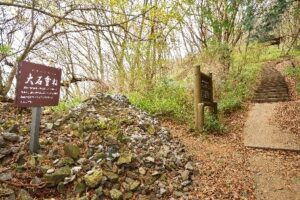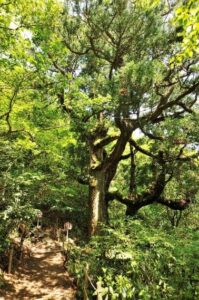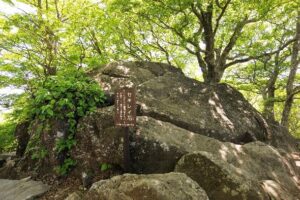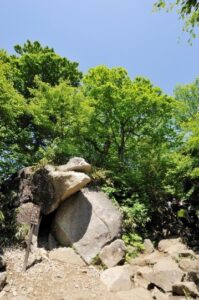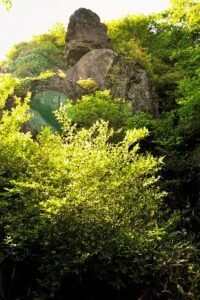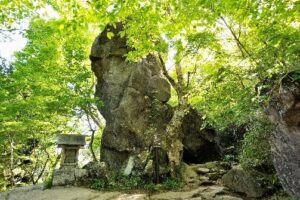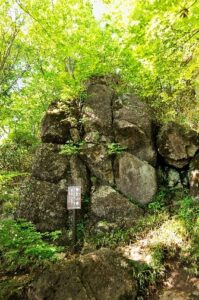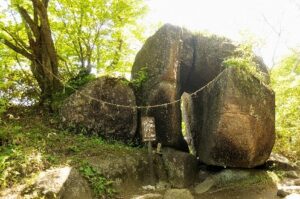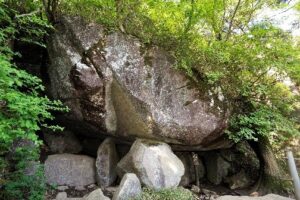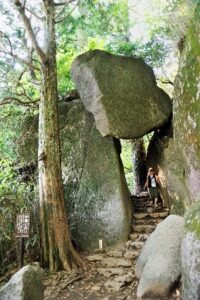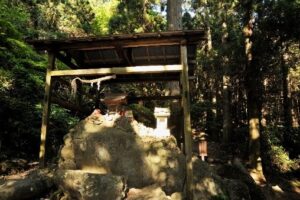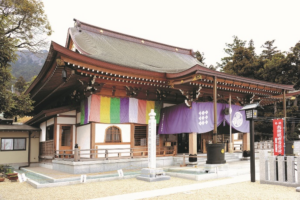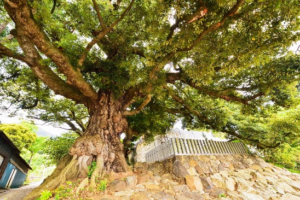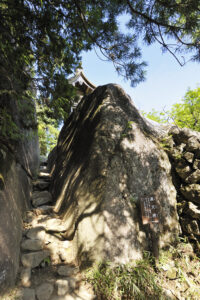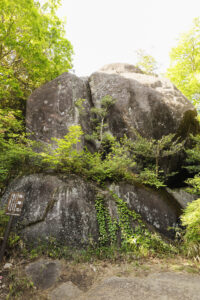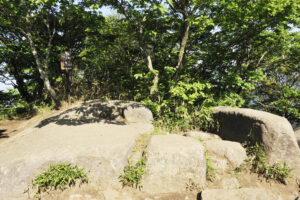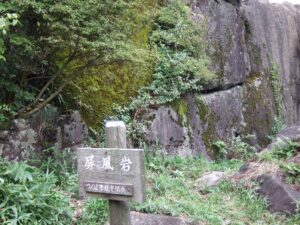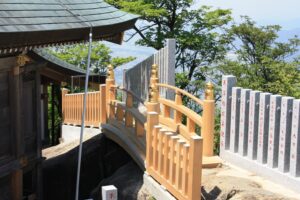筑波山パワースポット
Mt. Tsukuba power spot
1.筑波山神社:Tsukubasan-jinja Shrine
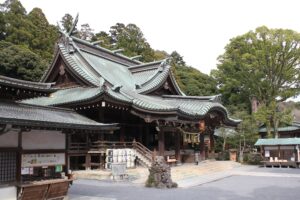
万葉の昔より信仰の対象と崇められてきた関東の霊峰「筑波山」を御神体として仰ぎ、筑波男大神伊弉諾尊(いざなぎのみこと)・筑波女大神伊弉冉命(いざなみのみこと)2柱を御祭神として祀る山岳信仰を今にとどめる全国屈指の古社です。
Tsukubasan-jinja Shrine, known for the blessings of marital harmony and good fortune, regards Mt. Tsukuba as an object of worship.
The summit offers a panoramic view of the entire Kanto area.
The historic shrine is located in the middle of the mountain to the summit.
2.立身石(りっしんせき):Rissin-Seki Rock
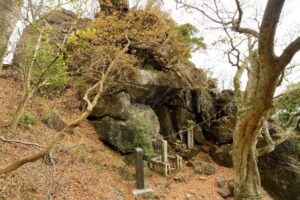
間宮海峡の発見で知られる間宮林蔵が少年時代に心願成就を祈願した地。また、親鸞聖人が餓鬼を救済した場所とも言われています。
This is the place where Rinzo Mamiya, known for discovering the Mamiya Strait, prayed for the fulfillment of his earnest wish when he was a boy. It is also said to be the place where Shinran Shonin, a holy priest, saved starving ghosts.
3.大石重ね(おおいしがさね):Oishi-Kasane
願いが神様に届くようにと小石を置いたのが始まり。
It is said that if you pile up a stone with your wishes on this spot, they will come true.
4.紫峰杉(しほうすぎ):Shiho Sugi
推定樹齢800年の巨木。近くには男女川(みなのがわ)が流れ、せせらぎと迫力ある巨木に癒やされるスポットです。
The huge 800-year-old Japanese cedar tree is one of the many power spots. Minanogawa is the name of the river that flows between Mt. Tsukuba and it flows nearby. And it is a spot where you can relax, heal your soul, and recharge your energy through the river’s murmuring sound and the giant trees’ powerful energy.
5.セキレイ石:Sekirei-Ishi Rock
この石の上に鶺鴒(せきれい)という鳥が留まり、イザナギノミコトとイザナミノミコトの二神に夫婦の道を教えたという言い伝えがあります。
It is said that a long time ago a wagtail bird perched on this stone and taught the two deities of ‘Izanagi-no-Mikoto’ and ‘Izanami-no-Mikoto’ how to get along well as husband and wife.
6.ガマ石:Gama-Ishi Rock
元来「雄龍石」といい、傍らには「雌龍石」もあり、その尾は霞ヶ浦に達すると言われている。一般には、永井兵助がこの石の前で「ガマの油売り口上」を考え出したことにより「ガマ石」と呼ばれ口の中に石を投げ込むと金運があがると言われています。
It is said that Heisuke Nagai, who developed the toad-oil (special ointment sold at Mt. Tsukuba) sales talk later, came up to the attractive words while he was sitting on the stone. This unusual-shaped stone had been called ‘Dragon Stone’ during the Edo period (1603-1867) and the imaginary-dragon’s tail is said to reach Lake Kasumigaura. If you put your hand into the mouth-like hole here, you might get luck with money.
7.大仏岩(だいぶついわ):Daibutsu-Iwa Rock
高さ15mもあり、大仏のように見える岩です。
The rock is 15m tall and looks like a giant Buddha.
8.北斗岩(ほくといわ):Hokuto-Iwa Rock
天にそびえたつ岩で、天空に輝く北斗星のように、決して動かないことを意味しています。その脇には祭神の月読尊(つくよみのみこと)を祀る筑波山神社の摂社「小原木神社」があります。
It is a rock that soars into the sky and, like the Big Dipper shining in the sky, is meant to never move. Obaragi Shrine, a branch shrine of Tsukubasan Shrine, stands by the rock, worshipping Tsukuyomi, a moon god. The deity is popular for answering prays for protecting agriculture, huge harvest, good fish-catch, safe voyage and family welfare.
9.裏面大黒(りめんだいこく):Rimendaikoku Rock
打ち出の小槌で有名な大黒様がその名のとおり大きな袋を背負っている後姿に見える岩です。
Daikoku-sama is a Buddhist monk famous for his hammered gavel. As the name suggests, this rock looks like the back of Daikoku-sama carrying a large sack on his back.
10.出船入船(でふねいりふね):DefuneーIrifune Rock
元来「熊野の鳥居石」といい船玉神を祀る。筑波山の修験者が2つの石の間を通し、紀州熊野を遥拝した。一般には、石の姿が出船と入船が並んでいるようにみえることにより現在のように呼ばれています。
The alignment of the stones gives an appearance that seems to be lined up with the ship’s departures and arrivals. Through the stone’s power, a prayer wishing for safety on the far and long distant sea journey.
11.母の胎内くぐり(ははのたいないくぐり):Haha-no-Tainai-Kuguri
筑波山禅定(修験の行)の行場の一つで、本来は岩の上部の穴より下へ抜ける。行を重ねこの岩を抜けることによって母より生まれたことと同じ意味を持ち、穢れのない姿に立ち返ることができると言われています。
This is a place of training for Zenjo (ascetic practice atop a sacred mountain). Going through the narrow space like a birth canal in the rock means returning to an innocent state of body and mind.
12.弁慶七戻り(べんけいななもどり):Benkei-Nanamodori Rock
元来「石門」といい、聖界(髙天原)と俗界(現世)を分ける門であるといわれ、大変神聖な場所とされる。
現在の呼び名は、豪傑の弁慶でさえも、頭上の岩が落ちてくるのではと7度も後ずさりしたことによるとされています。
This is a stone gate that is said to divide the sacred world from the mundane one. Since the huge rock looks as if it’s about to fall, Benkei, a strong warrior monk, is said to have hesitated to go through under the rock and he went ‘back and forth seven times.
13.白蛇弁天(はくじゃべんてん):Hakujyabenten
白い蛇が住んでいるといわれ、この白蛇を見ると財をなすとの伝説があります。
It is said a white snake inhabits here, and a legend says that seeing the white snake would make you rich.
14.筑波山大御堂(つくばさんおおみどう):Tsukubasan-Omido Temple
坂東33観音霊場の第25番札所で、良縁成就、交通安全、安産、家内安全、開運招福を祈る人々が訪れます。782年徳一上人の開基で、810年弘法大師空海が密教道場を開いた(知足院中禅寺)といわれています。
Omido Temple, the 25th temple of the 33 Bando Kannon temples, was founded in 782 by the holy priest Tokuitsu, and later opened as an esoteric Buddhist hall called Chisokuin Chuzenji Temple in 810 by Kobodaishi Kukai. People come here to pray for good luck and fortune such as a happy marriage, safe childbirth, well-being of family members, and traffic safety.
15.御霊木 大御堂 スダジイ:Sacredchinquapin tree(Castanopsis sieboldii)at Omido Temple, Mt.Tsukuba
大御堂を守護するスダジイは、高さ20メートル以上で樹齢400年。その姿はまるで森の中にいるかのようで、幹の模様は忘れられない印象を与えます。
The chinquapin that guards the Omido Temple stands at over 20 meters tall and is more than400 years old. Its presence is reminiscent of being within a forest, and the patterns on its trunk leave an unforgettable impression.
その他にもたくさん!
There are many more attractions of Mt.Tsukuba.
高天原(たかまがはら):Takamagahara
高天原とは日本神話で、天照大神(あまてらすおおみかみ)をはじめ多くの神々が坐す「神様の世界」。その天照大神(太陽神であり、天皇の祖神)を祀る筑波山神社の摂社「稲村神社」があります。
Takamagahara is said to be ‘God World’ where lots of heavenly gods including Amaterasu-Omikami dwelled. Inamura Shrine is near here, which worships Amaterasu-Omikami (goddess of the sun and ancestor deity of the emperor). This place is popular for answering praying for land stability, better fortune, luck in the game, and bringing happiness.
陰陽石(いんようせき):Yin Yang Stone
陰(地・女・月・夜・静・暗など)と陽(天・男・日・昼・動・明など)、相反する二つの巨大な岩が寄り添うようにそびえ立っています。
Yin implies negative things including the earth, female, the moon, night, stillness and the dark. Yang indicates positive things including the heaven, male, the sun, day, movement and light. The two opposite-meaning rocks seem to stand up close together.
国割り石(くにわりいし):Kuniwari Stone (land partition stone)
太古の昔、集まった神々がこの石の上に線を引き、それぞれの統治めるべき地方を割りふったといわれています。
Ages ago, the deities got together here and applied lines on this stone to decide what part of land each of them would rule.
屏風岩(びょうぶいわ):Byobu-Iwa (sheer cliff)
まるで屏風のように見えることから名付けられました。筑波山神社の摂社「安座常神社(あざとこじんじゃ)」があり、素戔鳴尊(すさのおのみこと※開祖の神)を祀っています。
Since this cliff looks as if a huge folding screen were standing straight, this place is called Byuobu-Iwa. Azatoko Shrine, a branch shrine of Tsukubasan Shrine, is near here and it is dedicated to Susano-no-Mikoto (the founder deity of the shrine). This place is popular for answering praying for protection from water-caused disasters, fire-caused disasters and various kind of diseases. Also, this deity is popular for prayers for good harvest, progress in studies and tying the knot.
天浮橋(あめのうきはし):Ame-no-Ukihashi (the floating bridge of heaven)
神代の昔、イザナギ、イザナミの二柱の神様が山頂の「天浮橋」(あめのうきはし)に立ち、玉で飾った天の沼矛(ぬぼこ)を下ろし、かき回したところ、その矛の先からしたたりおちた塩で成った島(オノコロジマ)が筑波山であり、天地開闢の地とされています。
One day during the time immemorial, the two pillar deities called ‘Izanaki’ and ‘Izanami’ stood on Ame-no-Ukihashi, and unloaded a jeweled spear called Ama-no-nuboko and stirred the primeval ocean with it. When they pulled up the spear, drops of salty water dripping down from it into the sea began to create an island called Onokorojima, which finally turned into Mt. Tsukuba. That’s why the mountain has been regarded as a place of heaven and earth creation.

